Activity
Similar Activities
Nature Explorers: Scavenger Hunt & Art
Children’s Age: 2–6 years
Activity Duration: 10 minutes
Let's go on a Nature Scavenger Hunt and Outdoor Art adventure! We will explore nature, collect items, and create beautiful artwork. You will need a bag, paper, crayons, watercolors…
Activity Duration: 10 minutes
Whispers of Love: Family and Friends Puzzle Match
Children’s Age: 3–4 years
Activity Duration: 10 minutes
"Family and Friends Puzzle Match" is designed for children aged 36 to 48 months to boost self-care skills, language development, and comprehension of family and friendship concepts…
Activity Duration: 10 minutes
Seasonal Shapes Playdough Sculpting Adventure
Children’s Age: 4–6 years
Activity Duration: 15 – 20 minutes
Engage children aged 48 to 72 months in a Playdough Sculpting activity focusing on seasonal shapes to boost fine motor skills, creativity, and emotional regulation. Provide playdou…
Activity Duration: 15 – 20 minutes
Eco-Friendly Piggy Bank Crafting: Saving with Style
Children’s Age: 10–12 years
Activity Duration: 35 – 45 minutes
In the Eco-Friendly Piggy Bank Crafting activity, children will make their piggy banks using stationery materials to learn about saving money, reusing items, and environmental awar…
Activity Duration: 35 – 45 minutes
Seasonal Photography - Imaginative Career Snapshot Adventure
Children’s Age: 11–15 years
Activity Duration: 50 minutes
Explore the world of photography careers and seasonal wonders with "Career Snapshot - Seasonal Photography," a captivating activity for children aged 11 to 15. Using digital camera…
Activity Duration: 50 minutes
Enchanted Clay Sculpture Storytelling Forest
Children’s Age: 6–10 years
Activity Duration: 15 – 30 minutes
Engage children aged 6 to 10 in the Clay Sculpture Storytelling activity to foster cultural understanding, play skills, and self-regulation. Gather air-dry or sculpting clay, a tab…
Activity Duration: 15 – 30 minutes
Magical Journeys: Around the World Adventure Board Game
Children’s Age: 8–12 years
Activity Duration: 30 – 35 minutes
Embark on the "Around the World Adventure Board Game" for an engaging and educational experience that nurtures ecological awareness, cultural development, and empathy in children. …
Activity Duration: 30 – 35 minutes
Dancing Through Cultures: Cultural Dance and Language Exploration
Children’s Age: 10–14 years
Activity Duration: 20 – 35 minutes
Explore various cultures and languages with the Cultural Dance and Language Exploration activity for children aged 10 to 14. This engaging experience fosters cultural appreciation,…
Activity Duration: 20 – 35 minutes
Sensory Music-Making Session: Sound Story Drawing Adventure
Children’s Age: 2–2.5 years
Activity Duration: 5 – 20 minutes
A sensory music-making activity using household items to enhance sensory development and introduce children to the world of music.
Activity Duration: 5 – 20 minutes
Empathy Harmony: Musical Language Exchange Adventure
Children’s Age: 11–15 years
Activity Duration: 35 – 45 minutes
The "Musical Language Exchange" activity is designed for children aged 11 to 15 to explore empathy through music, instruments, and foreign languages. Participants will engage with …
Activity Duration: 35 – 45 minutes
Musical Instrument Exploration: Symphony of Sensory Play
Children’s Age: 1.5–2 years
Activity Duration: 10 minutes
Explore the Musical Instrument Exploration activity for children aged 18 to 24 months, promoting play skills, self-regulation, and communication development through a sensory-rich …
Activity Duration: 10 minutes
Enchanted Musical Storytime Adventure
Children’s Age: 2–2.5 years
Activity Duration: 5 – 15 minutes
Join the "Musical Storytime Adventure" for children aged 24 to 30 months, focusing on self-regulation development. Gather favorite storybooks, musical instruments, a cozy rug, and …
Activity Duration: 5 – 15 minutes



























